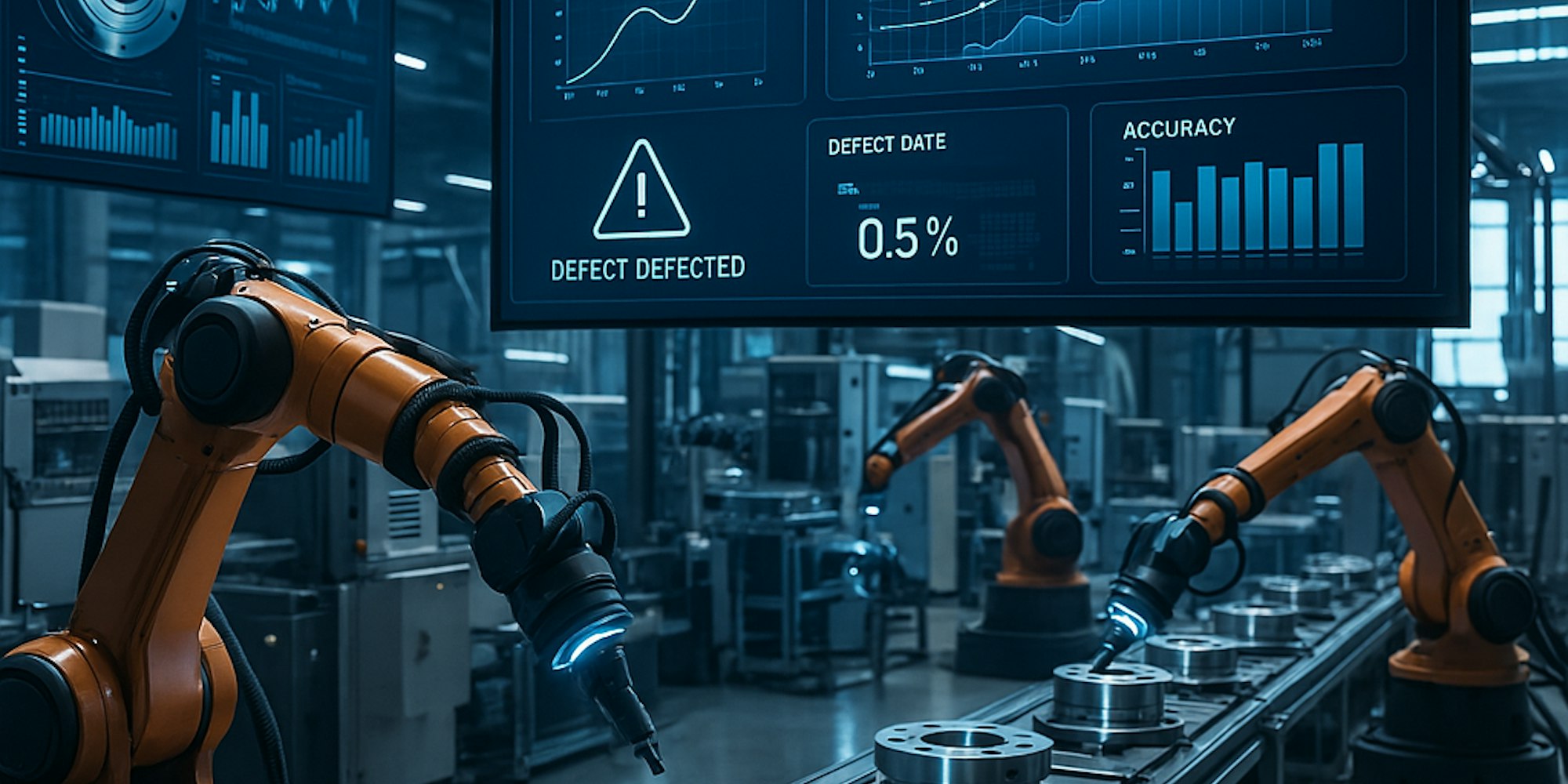Artificial Intelligence
15 min read
AI-Driven Predictive Quality Control: Revolutionizing Manufacturing Excellence
The manufacturing industry is undergoing a significant transformation with the emergence of AI-driven predictive quality control as a key component of Industry 4.0. This advanced approach is poised to revolutionize traditional quality management systems, providing unprecedented capabilities in maintaining product excellence while optimizing operational efficiency. A thorough examination of AI-driven predictive quality control reveals its potential to transform the manufacturing landscape, enabling organizations to produce high-quality products while minimizing waste and reducing costs.
The foundation of AI-driven predictive quality control lies in its sophisticated technological infrastructure, which combines real-time monitoring, advanced analytics, and machine learning capabilities. This system processes vast amounts of data, providing manufacturers with a comprehensive understanding of their production processes. The technological infrastructure comprises several key components, including advanced sensor networks, real-time analytics, and machine learning integration. These components work in tandem to identify subtle pattern deviations, predict potential quality issues, and recommend optimal process adjustments.
Understanding the AI-Powered Quality Control Framework
The AI-powered quality control framework is built on a robust technological infrastructure that enables real-time monitoring and analysis of production processes. This framework consists of several key components, including:
- Advanced Sensor Networks: Modern manufacturing facilities utilize an extensive network of IoT sensors that continuously monitor critical production parameters, such as temperature variations, pressure fluctuations, vibration patterns, material flow rates, and equipment performance metrics.
- Real-Time Analytics: The core strength of predictive quality control lies in its ability to process and analyze data instantaneously. Advanced machine learning algorithms identify subtle pattern deviations, predict potential quality issues, and recommend optimal process adjustments.
- Machine Learning Integration: The AI system learns continuously from new data inputs, enabling it to refine its predictions and recommendations over time.
The implementation of AI-driven predictive quality control has numerous benefits, including improved product quality, reduced waste, and enhanced operational efficiency. For instance, a leading automotive manufacturer implemented AI-driven quality control in their welding operations, achieving a 38% reduction in defect rates, a 45% decrease in quality-related downtime, and $2.3 million annual savings in warranty claims.
Process Optimization and Resource Efficiency
AI systems continuously optimize manufacturing processes by analyzing production parameters' impact on quality, suggesting optimal settings for different conditions, reducing material waste through predictive maintenance, and minimizing energy consumption through smart scheduling. This is achieved through:
1. Analyzing production parameters: AI systems analyze the impact of various production parameters on product quality, enabling manufacturers to identify areas for improvement.2. Suggesting optimal settings: The AI system suggests optimal settings for different conditions, such as temperature, pressure, and material flow rates, to ensure consistent product quality.3. Reducing material waste: Predictive maintenance enables manufacturers to reduce material waste by identifying potential equipment failures and scheduling maintenance accordingly.4. Minimizing energy consumption: Smart scheduling enables manufacturers to minimize energy consumption by optimizing production schedules and reducing energy-intensive processes.
Implementation Strategy and Best Practices
- Successful deployment of AI-driven quality control requires a structured approach, including:
- Data Infrastructure Development: Establishing robust data collection systems, implementing secure data storage solutions, ensuring data quality and consistency, and deploying edge computing capabilities.
- Model Development and Training: Creating accurate predictive models using historical data, continuously refining algorithms based on new inputs, validating model accuracy through rigorous testing, and implementing feedback loops for continuous improvement.
- System Integration: Seamless integration with existing MES and ERP systems, real-time communication protocols, automated response mechanisms, and user-friendly interfaces for operators.
Challenges and Solutions
While implementing AI-driven quality control, manufacturers face several challenges, including:
- Data Quality and Availability: Insufficient historical data for model training can be addressed by implementing comprehensive data collection systems and starting with pilot programs.
- Technical Expertise: A shortage of skilled AI professionals can be addressed by partnering with specialized service providers and investing in employee training.
- Change Management: Resistance to new technology adoption can be addressed by implementing phased deployment and comprehensive training programs.
Future Trends and Industry Impact
The evolution of AI-driven quality control is shaping several emerging trends, including:
- Advanced AI Capabilities: Enhanced computer vision systems, natural language processing for maintenance, autonomous quality decision-making, and predictive maintenance integration.
- Edge Computing Integration: Faster data processing, reduced latency in quality decisions, improved real-time response capabilities, and enhanced security through localized processing.
Key Benefits and ROI Metrics
Organizations implementing AI-driven quality control typically experience:
- 25-35% reduction in quality control costs
- Up to 50% decrease in defect rates
- 20-30% improvement in equipment effectiveness
- 40% reduction in customer complaints
Practical Implementation Guidelines
For manufacturing executives considering AI-driven quality control, the following steps can be taken:
1. Assessment Phase: Evaluate current quality control processes, identify specific areas for AI implementation, calculate potential ROI and resource requirements, and develop an implementation timeline.
2. Pilot Program: Select a high-impact, low-risk area for initial deployment, establish clear success metrics, gather and analyze performance data, and scale based on pilot results.
In conclusion, AI-driven predictive quality control represents a fundamental shift in manufacturing excellence. Organizations embracing this technology position themselves at the forefront of Industry 4.0, gaining competitive advantages through improved product quality, reduced waste, and enhanced operational efficiency. As AI technology continues to evolve, manufacturers must stay informed and prepared to adapt their quality control strategies to maintain market leadership. To get started, manufacturing executives can evaluate their current quality control processes and consider how AI-driven solutions can enhance their manufacturing excellence journey. Take the first step towards revolutionizing your manufacturing operations with AI-driven predictive quality control.
Reference Links:
https://www.pecan.ai/blog/unlocking-predictive-quality-control/
https://www.datategy.net/2024/11/25/how-ai-transforms-quality-control-in-modern-manufacturing/
Get the latest updates
We only send updates that we think are worth reading.



